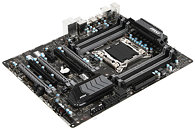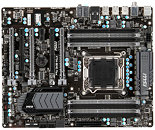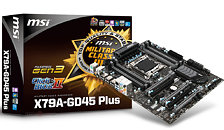- Joined
- Oct 9, 2007
- Messages
- 47,611 (7.45/day)
- Location
- Dublin, Ireland
| System Name | RBMK-1000 |
|---|---|
| Processor | AMD Ryzen 7 5700G |
| Motherboard | Gigabyte B550 AORUS Elite V2 |
| Cooling | DeepCool Gammax L240 V2 |
| Memory | 2x 16GB DDR4-3200 |
| Video Card(s) | Galax RTX 4070 Ti EX |
| Storage | Samsung 990 1TB |
| Display(s) | BenQ 1440p 60 Hz 27-inch |
| Case | Corsair Carbide 100R |
| Audio Device(s) | ASUS SupremeFX S1220A |
| Power Supply | Cooler Master MWE Gold 650W |
| Mouse | ASUS ROG Strix Impact |
| Keyboard | Gamdias Hermes E2 |
| Software | Windows 11 Pro |
MSI launched the X79A-GD45 PLUS socket LGA2011 motherboard, targeting the US $200~250 price-range. The board uses a 9-phase DrMOS VRM to power the CPU socket, which is wired to eight DDR3 DIMM slots, supporting up to 128 GB of quad-channel DDR3-2400 MHz memory; and three PCI-Express 3.0 x16 slots (gray). The other two PCI-Express x16 slots (black) are electrical gen 2.0 x4, and wired to the X79 PCH. A lone PCI-Express 2.0 x1 finds some room in there.
The X79A-GD45 PLUS sticks to the chipset's feature-set, with very little third-party controller functionality. Storage connectivity includes two SATA 6 Gb/s and three SATA 3 Gb/s, all of which are internal ports. The board features four USB 3.0 ports (two on the rear panel, two by headers), 8-channel HD audio with optical and coaxial SPDIF outputs, gigabit Ethernet, PS/2 mouse/keyboard, and a number of USB 2.0/1.1 ports making up the rest of the connectivity. It is driven by an AMI UEFI BIOS, with a few overclocker-friendly features such as diagnostic LEDs, POST state display, accessible CMOS reset button, etc.



View at TechPowerUp Main Site
The X79A-GD45 PLUS sticks to the chipset's feature-set, with very little third-party controller functionality. Storage connectivity includes two SATA 6 Gb/s and three SATA 3 Gb/s, all of which are internal ports. The board features four USB 3.0 ports (two on the rear panel, two by headers), 8-channel HD audio with optical and coaxial SPDIF outputs, gigabit Ethernet, PS/2 mouse/keyboard, and a number of USB 2.0/1.1 ports making up the rest of the connectivity. It is driven by an AMI UEFI BIOS, with a few overclocker-friendly features such as diagnostic LEDs, POST state display, accessible CMOS reset button, etc.



View at TechPowerUp Main Site




 Who seen it IRL?
Who seen it IRL?